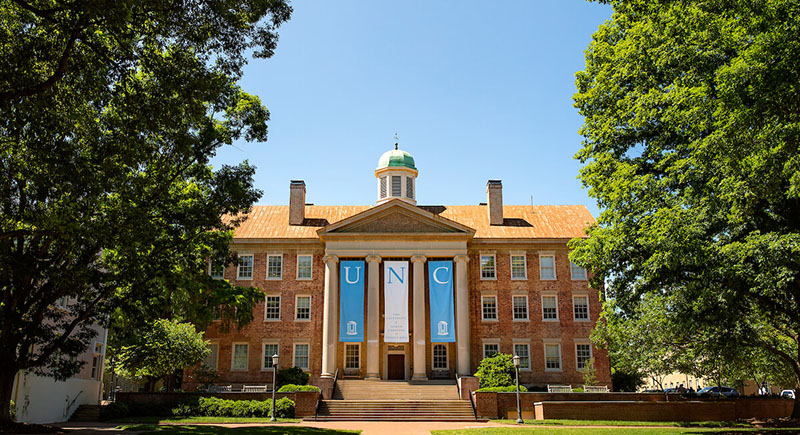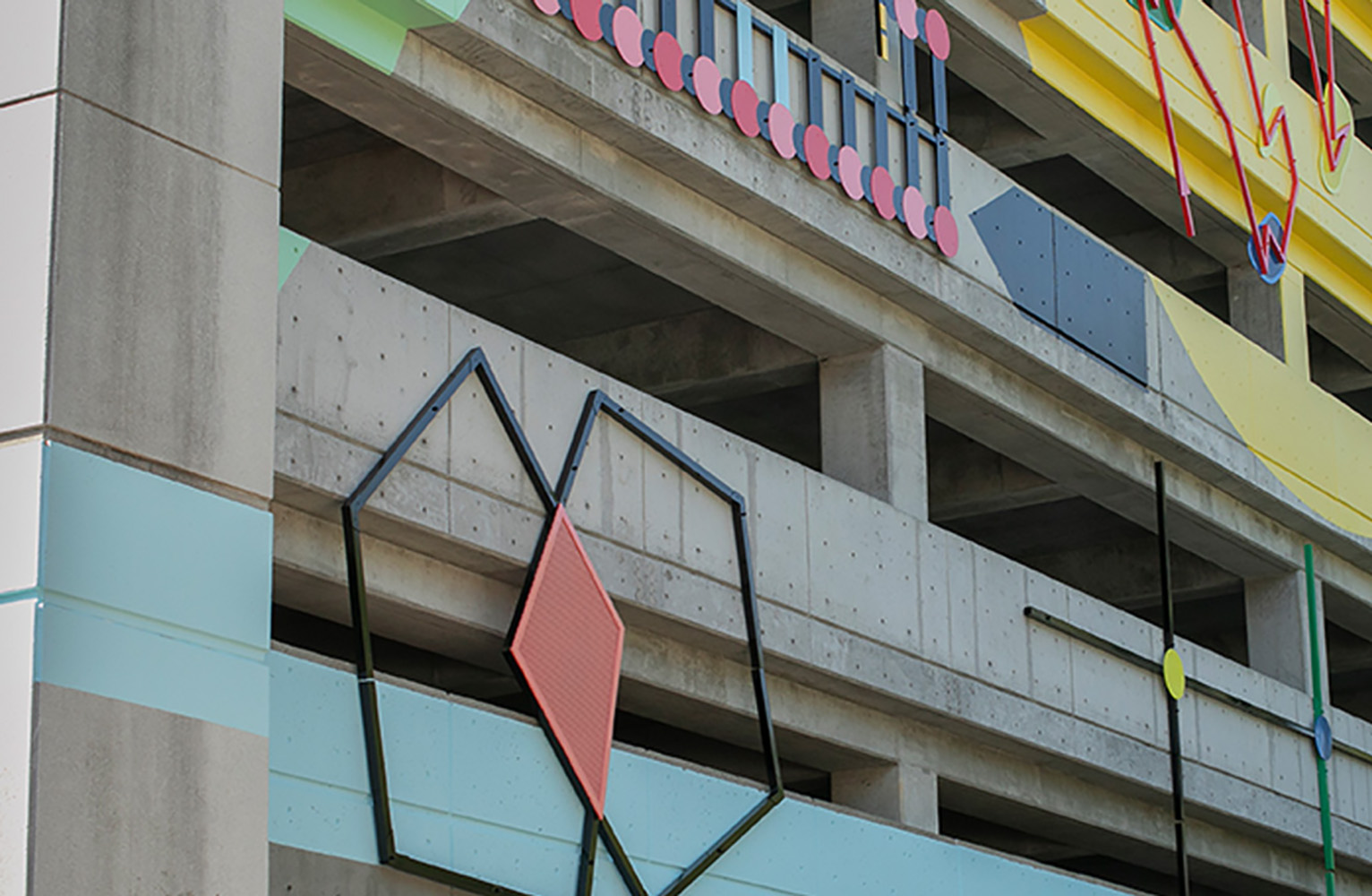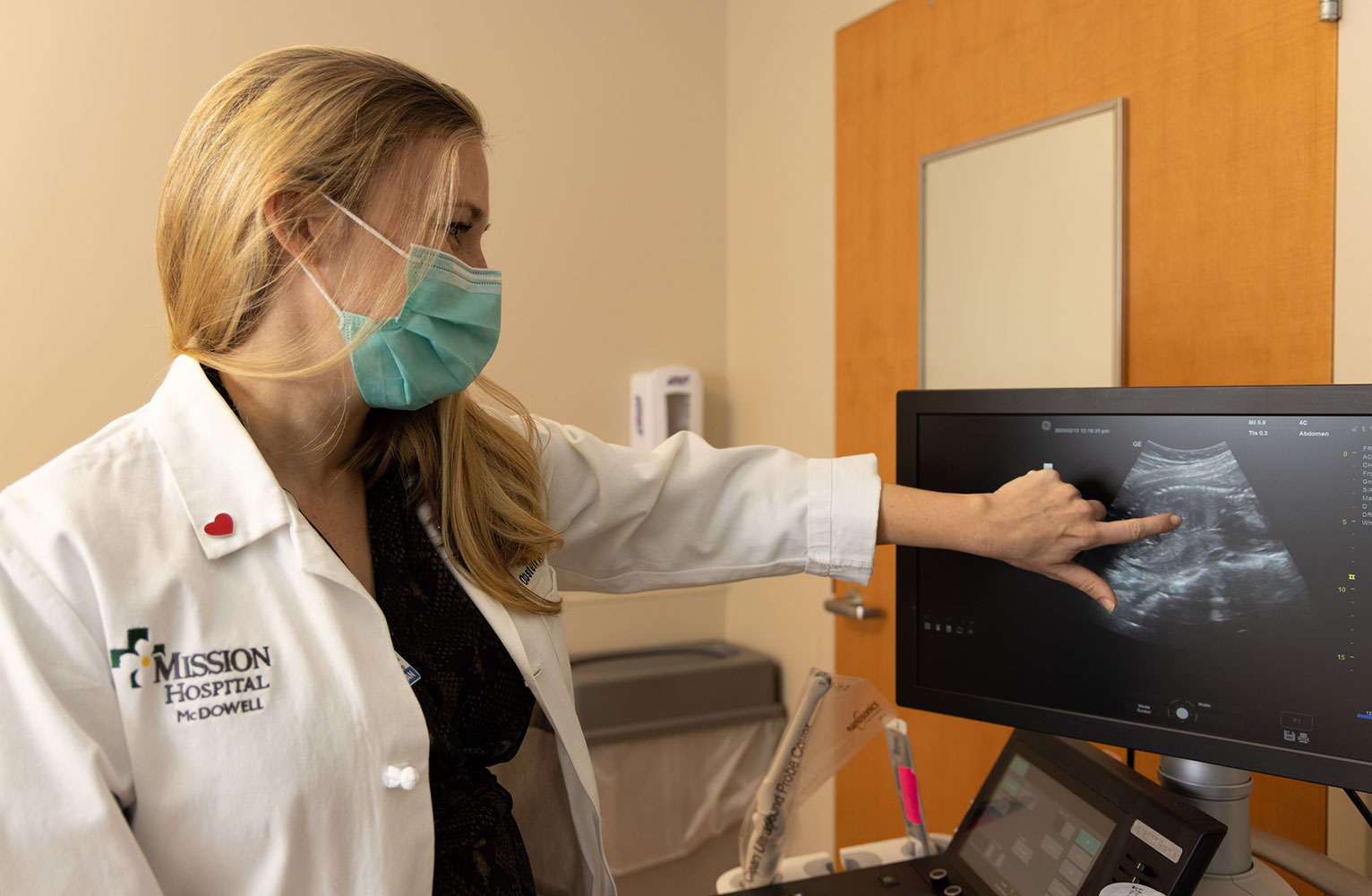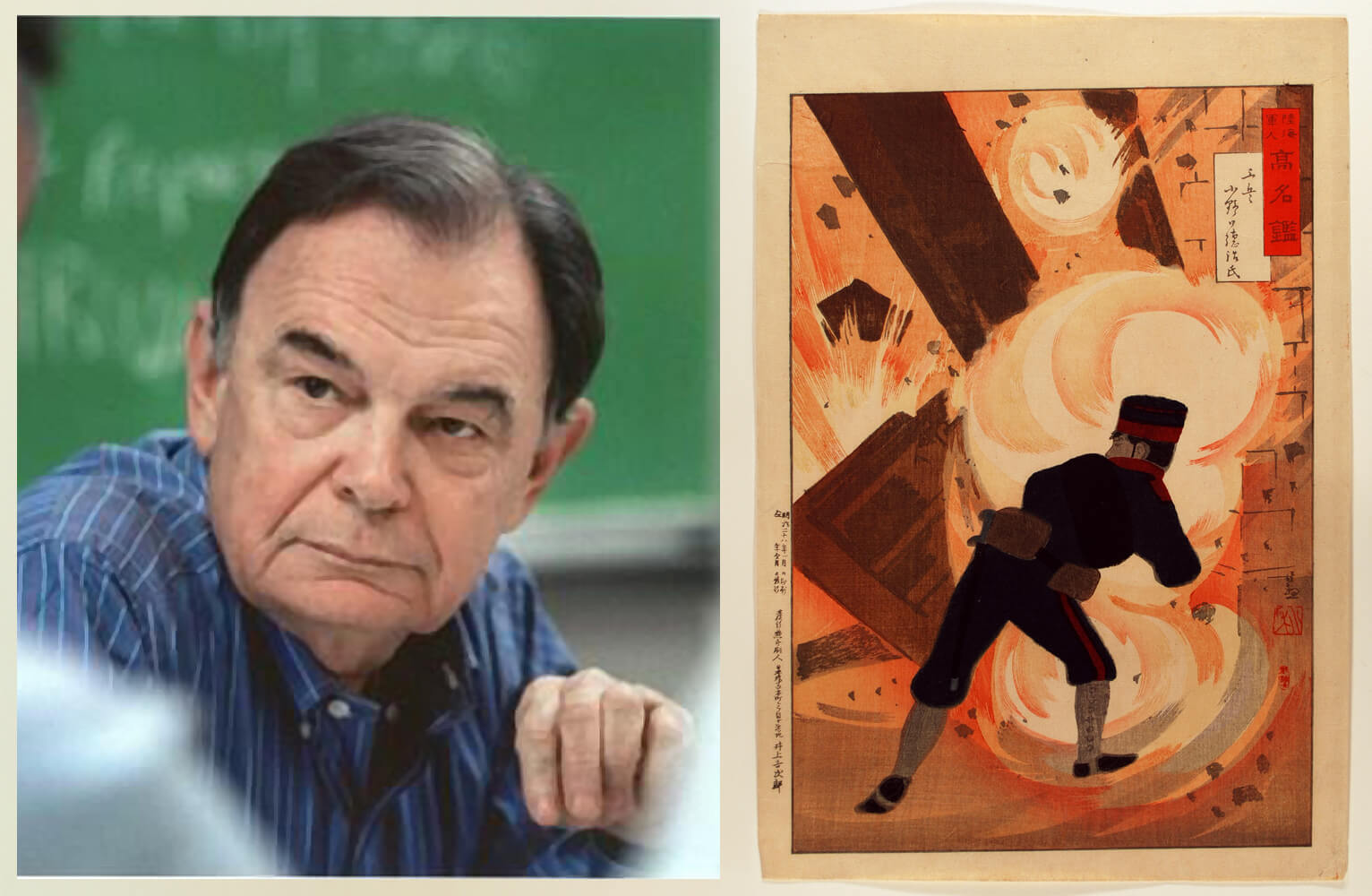
Left: Pulitzer Prize–winning journalist and Carolina alumnus Gene Roberts ’54 (Courtesy of University of Maryland); Right: An 1895 woodblock print by Kobayashi Kiyochika (full citation below)
From war correspondent to professor: Renowned journalist’s donated art collection complements the trajectory of his career.
By Angela Harwood
The legacy of Carolina alumnus Gene Roberts ’54 is that of a Pulitzer Prize–winning journalist and editor who fearlessly pursued the truth, challenged the status quo and left an enduring impact on the practice of journalism. But throughout his impressive career, he amassed another legacy: an immense collection of Japanese woodblock prints — the majority of which he and his wife, Susan Roberts, donated to the Ackland Art Museum at UNC-Chapel Hill.
Gene Roberts’ interest in Asian art began during the Vietnam War, when he was a war correspondent for The New York Times.
“After I got back to the United States, I was looking at reference books about Asian art, and I saw some copies of triptychs from the Chinese-Japanese War — often called the Sino-Japanese War — in 1894-95,” said Roberts. “I thought it was interesting to cover a war with woodblocks as opposed to news stories.”
As a war correspondent, Roberts crawled into battle on his stomach or flew in and out of action on medical evacuation helicopters. He was naturally intrigued by how Japan covered the war with China. “The truth is, very few of the woodblock artists ever went into the field and saw the troops,” he said. “Instead they used their imaginations to create these illustrations.”
Prints as journalism?
Roberts continued to pursue his interest in war prints, leading him to the works of Yoshitoshi Tsukioka and Kobayashi Kiyochika — two prominent printmakers from the Meiji period. His curiosity expanded beyond war to prints showing Japan’s transformation from an isolated country in the 1850s to its rapid modernization.
Roberts, who confessed an initial desire to major in history at Carolina before he decided on journalism, became absorbed in the rich history of the Meiji period, spanning from 1868 to 1912. He accumulated thousands of prints that reflect history in the making: from the end of the shogunate and the samurai to the radical social and political shifts as Japan and its newly empowered emperor embraced Western ideas, built an imperial military and fought two wars.
Individually and collectively, the prints in Roberts’ collection tell stories — offering glimpses into how Japan built its relationship with the wider world, how the Japanese saw Americans, how the emperor wanted to be seen by the general public.
“These prints are like journalism in a way, but not objective — a kind of propaganda,” said Peter Nisbet, deputy director for curatorial affairs at the Ackland Art Museum.
Story continues below gallery
 VIEW CAPTION
VIEW CAPTION
A triptych woodblock print from the Chinese-Japanese War, much like this one, sparked Roberts’ interest in Asian art.
Kobayashi Toshimitsu, Japanese, active 1877-1904, The Great Naval Battle of the Yalu River, 1894, polychrome woodblock print, 14 × 27 9/16 in. (35.5 × 70 cm). The Gene and Susan Roberts Collection, 2015.11.110.
 VIEW CAPTION
VIEW CAPTION
Roberts’ interest expanded beyond war to prints showing Japan’s rapid industrialization.
Tsukioka Yoshitoshi, Japanese, 1839-1892, Illustration of Steam Locomotive Tracks at Takanawa 1871, polychrome woodblock print, 14 1/8 × 28 3/4 in. (35.9 × 73 cm). The Gene and Susan Roberts Collection, 2021.20.117a-c.
 VIEW CAPTION
VIEW CAPTION
Roberts accumulated a comprehensive collection of prints reflecting the Satsuma Rebellion.
Yoshitora Utagawa, Japanese, active 1850-1870, The Fierce Battle of Kumamoto Castle in the Satsuma Rebellion, 1877, polychrome woodblock print, 13 3/4 × 27 7/8 in. (34.9 × 70.8 cm). The Gene and Susan Roberts Collection, 2021.51.44a-c.
 VIEW CAPTION
VIEW CAPTION
Many of the prints in Roberts’ collection are “a kind of propaganda,” like this one showing the Meiji emperor and empress as they wanted to be viewed by the public.
Yōshū Chikanobu, Japanese, 1838-1912, Emperor Enjoying the Cherry Blossoms Along the Sumida River, 1888, polychrome woodblock print, 14 7/16 × 28 3/16 in. (36.7 × 71.6 cm). The Gene and Susan Roberts Collection, 2022.46.35a-c.
 VIEW CAPTION
VIEW CAPTION
Kiyochika’s prints show Japan’s modernization in a more subtle way than those of his peers.
Kobayashi Kiyochika, Japanese, 1847-1915, Fireworks at Ike-no-hata (Ike-no-hata hanabi), c. 1881, polychrome woodblock print, 9 3/4 × 14 3/16 in. (24.8 × 36.1 cm). The Gene and Susan Roberts Collection, 2022.28.36.
 VIEW CAPTION
VIEW CAPTION
Kiyochika’s depiction of Japan’s wars with China and Russia were more exultant than his earlier prints.
Kobayashi Kiyochika, Japanese, 1847-1915, Engineer Onoguchi Tokuji, from the series Mirror of Army and Navy Heroes, 1895, polychrome woodblock print, 14 5/8 × 9 15/16 in. (37.1 × 25.2 cm). The Gene and Susan Roberts Collection, 2014.40.7.
‘Zig instead of zag’
For a journalist whose self-professed style is to “zig instead of zag,” it’s not surprising that of the 1,199 prints he’s donated to the Ackland, among Roberts’ favorites are those by Kiyochika.
“He was one of the first to really master light and shadow,” Roberts noted.
Kiyochika’s prints differ from his peers’ in other significant ways, as noted in an essay by James T. Ulak, senior curator of Japanese art at the Smithsonian’s National Museum of Asian Art. While his contemporaries “zagged,” rendering Japan’s modernization in a bright light — colorfully illustrating steamships, telegraph wires, European fashions and architecture — Kiyochika’s woodblocks “zigged.” His prints are more austere, his depiction of Western elements more subtly placed in the backgrounds and margins.
Kiyochika was around 6 years old when Commodore Matthew Perry’s ships entered Tokyo Bay, set on ending Japan’s isolation, threatening military might and laden with gifts for the emperor. In 1868, at 21 years old, he followed the overthrown shogun into exile. As Ulak suggests, perhaps Kiyochika wasn’t as enthusiastic about Japan’s transformation as his peers. However, as Japan emerged as an imperialist power, his prints depicting the Chinese-Japanese and Russo-Japanese wars became more exultant, almost celebratory.
Prints on display
In 2017, the Ackland Art Museum displayed around 80 prints from Roberts’ donated collection, including prints by Kiyochika, in the exhibition, Flash of Light, Fog of War: Japanese Military Prints, 1894-1905. The exhibition examined how the printmakers created dynamic compositions that were part reportage and part dazzling artistic display.
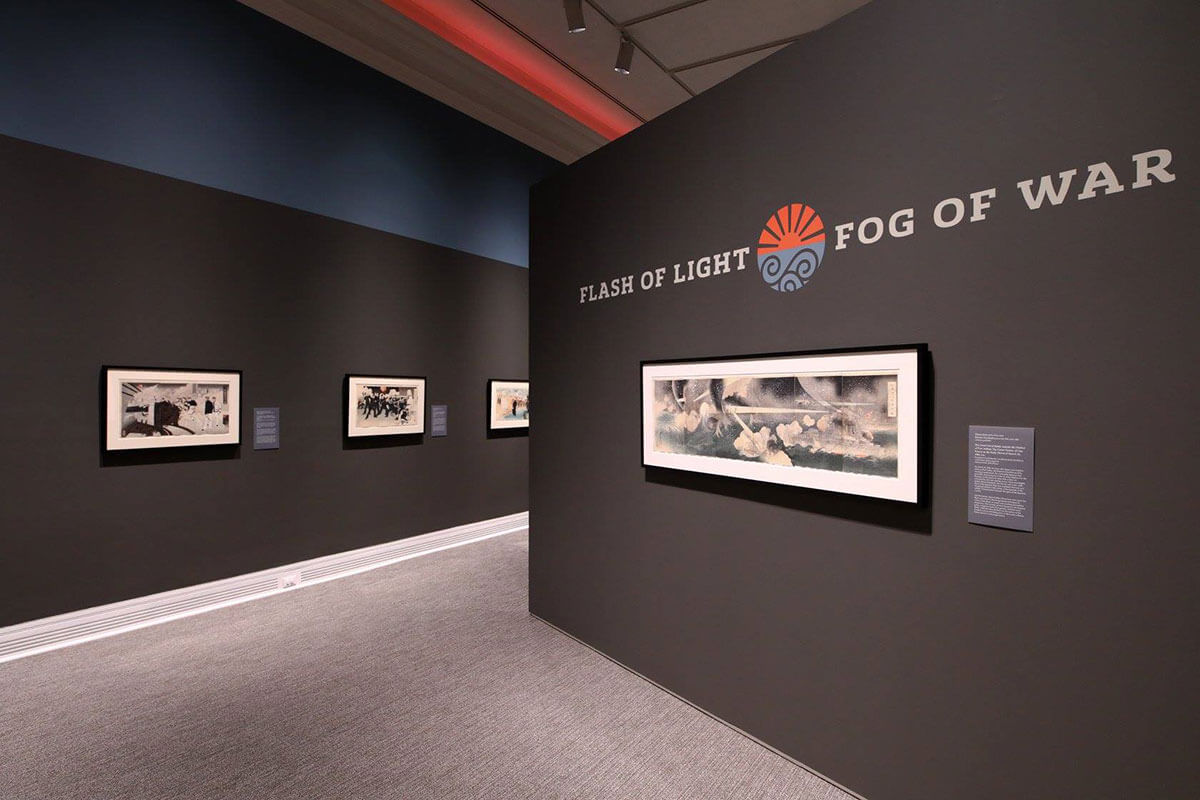
The Flash of Light, Fog of War exhibition at the Ackland Art Museum featured around 80 prints from the Gene and Susan Roberts Collection. (Courtesy of the Ackland Art Museum)
Most recently in 2022 and 2023, the Ackland featured Meiji period prints from Roberts’ collection in four installations focused on transportation, the Satsuma Rebellion, fashion and identity, amusements and entertainment. Doctoral student Megan McClory, who is studying in Japan during the spring of 2024, helped prepare the first two exhibitions.
“It was amazing being a part of these projects,” shared McClory. “Many people don’t know about this incredible repository of Japanese images. It’s a great opportunity to get more people interested, not just in Japanese art, but in history, too. We’ve barely touched the surface of the Roberts’ collection, and I’m excited to see what the wonderful staff at the Ackland will do with it next.”
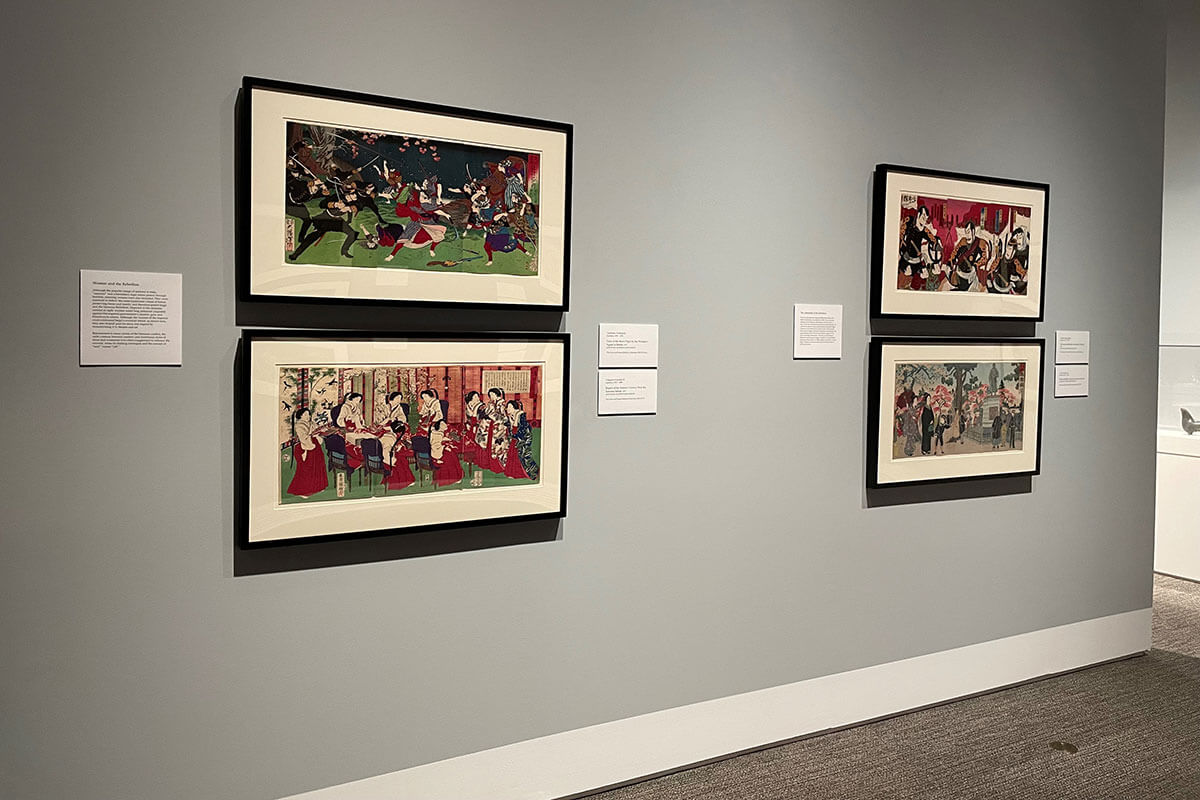
Doctoral student Megan McClory helped prepare an exhibition featuring prints depicting the Satsuma Rebellion. (Courtesy of the Ackland Art Museum)
As for future projects, the Ackland is considering a full-scale exhibition and publication of prints related to the Satsuma Rebellion, its precursors and aftermath; 2027 marks the 150th anniversary of that pivotal event that effectively led to the end of the samurai class.
These past and future exhibitions fulfill Roberts’ main goal in donating this collection. “When the prints are visible or on display over time, they will broaden people’s views of Japan and Asia,” he said.
Why a university museum?
Roberts spent a lifetime assembling a rich art collection that curators, academics and history buffs can delve into from many angles. So why give these prints to a university art museum?
Roberts served in the army for two years after graduating from Carolina. He was stationed in Washington, D.C., working for the Counter Intelligence Corps, “blessedly, in civilian clothes,” he laughed. He began to visit art museums, particularly enjoying the National Gallery.
“I thought about how nice it would’ve been to have a museum on campus that I could have gone to as a student,” he said, noting that the Ackland opened in 1958, four years after he graduated from Carolina. “So all these years later, I thought if I were going to do something charitable, I would focus on the Ackland and give them a strong print collection.”
A strong print collection, indeed. “This must be one of the best collections of this material in the U.S.,” noted Nisbet.
Ackland director Katie Ziglar added, “Gene and Susan’s remarkable trove of Japanese Meiji prints is a most welcome addition to the Ackland’s distinguished collection of over 16,500 works on paper. This gift helped us decide to feature a dedicated Center for International Art on Paper, where the Roberts’ prints will often be exhibited, in the new wing of the Ackland at Porthole Alley — anticipated to open in 2028.”
Art at your (gloved) fingertips
Thanks to his later career as a professor of journalism at the University of Maryland, Roberts also understands how his collection can be used for teaching and scholarship, another benefit of having an art museum on campus.
Morgan Pitelka, a distinguished professor with joint appointments in the history and Asian and Middle Eastern studies departments in the UNC College of Arts and Sciences, shared three ways the Meiji print collection will be useful.
The first is undergraduate teaching. “I teach a whole range of classes about Japan, and having students go to the Ackland and see the prints is a basic way to get them out of the humdrum daily routine, and it’s always exciting to them,” Pitelka shared. He also uses images of the prints in his lectures and teaches his students how to look them up in the Ackland’s publicly accessible online database.
“Essentially, this gives them a sense of ownership, their connection to the prints a part of the whole package students get access to when they come to UNC-Chapel Hill.”
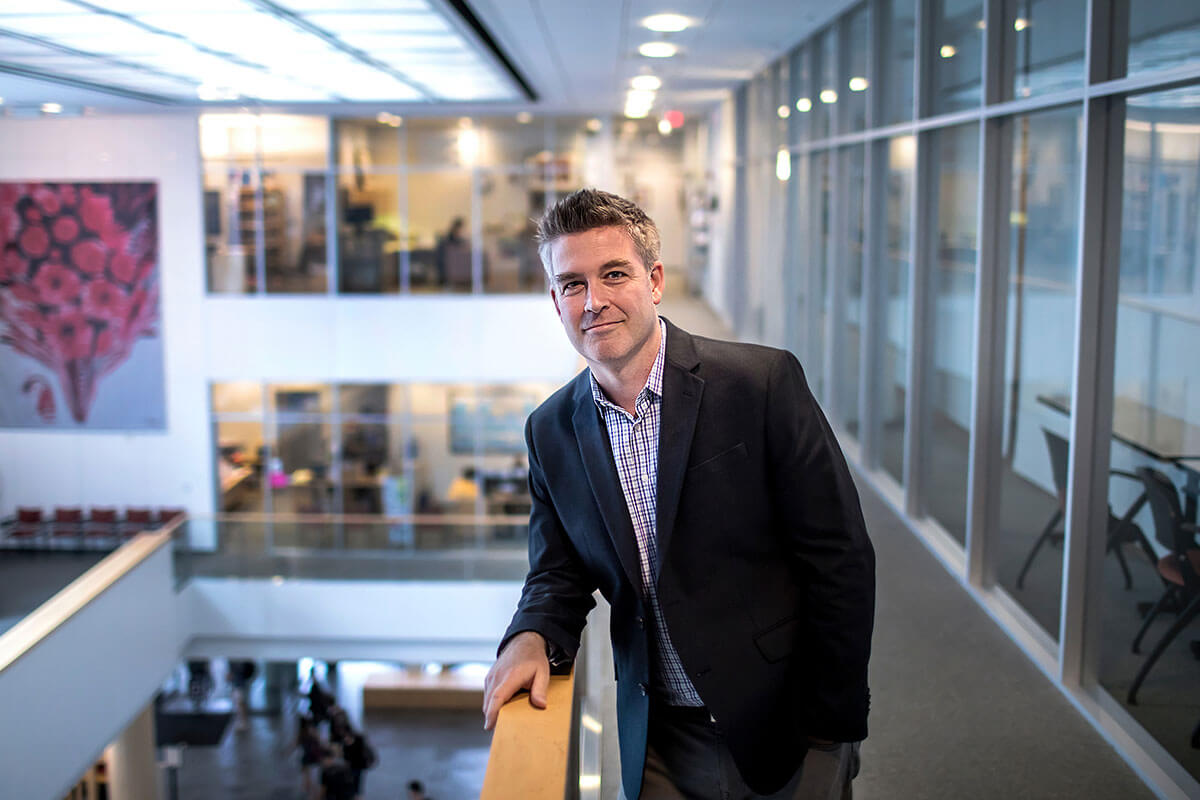
Morgan Pitelka is the Bernard L. Herman Distinguished Professor in the UNC College of Arts and Sciences. (Photo by Johnny Andrews)
Pitelka regularly teaches graduate students, as well, introducing them to materials they could research for their master’s theses and PhD dissertations.
“These are original, challenging sources that are exactly the kind of thing that can be useful when you’re doing advanced scholarly work,” he said. “I sometimes bring graduate students to the print room at the museum, where they get to examine prints in person, using gloves and under the watchful eye of a curator.”
Third, Pitelka said he can use the Meiji prints in the Japanese History Lab, a research group of graduate and undergraduate students — and sometimes high school students. Each semester, the lab conducts a collaborative research project.
“We may very well tackle this gift, this collection, as one of our research projects in the near future, where we translate the writing on the prints or curate an online exhibition. Or we could write lesson plans for K-12 teachers who might want to work with these prints.
“So there’s a whole variety of pedagogical uses for these materials. For me, that’s very exciting,” Pitelka concluded.
Thinking like a curator
Beyond exposing students to art that’s available for them to study and experience, Pitelka likes the idea of giving every student the chance to “think like a curator.” He often gives students the assignment of putting together miniature online exhibitions.
“I like that it puts them in the position of understanding that bringing objects together is a way of creating meaning,” he said. “You’re telling a story, and you can tell different stories with the same objects by arranging or framing them in different ways.”
He also likes that these assignments encourage students to start thinking about museums as sources of truth.
“They start to understand that when you go to museums, you’re not just encountering the truth, you’re encountering someone else’s story, and you can ask, ‘Who told this story? Why did they tell it this way and not another way?’”
Roberts tells his own story, in a way, through the art he chose to collect and his decision to donate that art to the Ackland. His collection complements the trajectory of his career and stands as a living testament to the intersection of storytelling and his lifelong commitment to understanding and interpreting the world in all its complexity.
Related Stories
